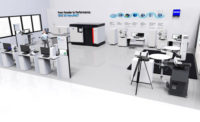Additive Manufacturing & Quality
Be sure your additively manufactured parts meet quality requirements.

Additively manufactured parts face unique testing challenges. Along with many aspects of additive manufacturing, testing and inspection of additively manufactured parts is now being studied. Last October the ASTM International Additive Manufacturing Center of Excellence announced its first set of R&D projects.
In partnership with Auburn University, one project will be looking at the effects of design parameters on tensile and fatigue properties of additive manufactured parts. (Project: Effects of Design Parameters on Tensile and Fatigue Properties of Additive Manufactured Parts Fabricated Using Laser Powder Bed Fusion Process). The impact of the project is explained this way: “Auburn University will investigate mechanical testing issues with metal additive manufacturing to better understand the relationships between the properties of test specimens and the performance of parts.”
Additional research is directed at post-processing, feedstock, process qualification, and non-metallic additive manufacturing testing. Standards are another area of concern for those in the industry.
Ralph Resnick, founding director of America Makes, and president and CEO of the National Center for Defense Manufacturing and Machining, put it this way: “We need to be sure that whatever is going to be produced is going to be consistent, safe, and of high quality. We need to be able to formalize the rules and the ways that we make things with additive manufacturing and that’s why standards are so critical.”
A slew of ASTM committees are hard at work developing a range of standards related to additive manufacturing, from design to materials and processes to terminology and test methods. Test methods may vary from those used with traditionally manufactured parts, and thus call for specific standards.
The ASTM F3122-14 is one such standard (ASTM F3122-14, Standard Guide for Evaluating Mechanical Properties of Metal Materials Made via Additive Manufacturing Processes, ASTM International, West Conshohocken, PA, 2014, www.astm.org).
According to ASTM, “This standard serves as a guide to existing standards or variations of existing standards that may be applicable to determine specific mechanical properties of materials made with an additive manufacturing process. As noted in many of these referenced standards, there are several factors that may influence the reported properties, including material, material anisotropy, method of material preparation, porosity, method of specimen preparation, testing environment, specimen alignment and gripping, testing speed, and testing temperature.”
The importance of standards is clear, whether in terms of materials or methods of manufacturing. Though there are many phases of the additive manufacturing process, testing is one of the most critical. According to an article from Deloitte, “Perhaps no other portion of the DTAM [digital thread for additive manufacturing] demonstrates the necessity of standards better than test + validate. It is here that manufactured parts are compared against their original requirements to validate they have been produced to pre-established quality parameters.”
As the standards process moves forward, mechanical testing of AM parts continues. This continues to be an important area of interest.
According to an article in the journal JOM, “One of the key aspects for qualification of AM parts/components is the mechanical performance that requires a wide range of mechanical testing/characterization.”
The challenge of testing and inspecting additively manufactured parts may be new to many companies. With every new method of manufacturing comes another outlook on inspection. Even within additive manufacturing, this could mean inspection for selective laser sintering, binder jetting, vat polymerization, or any number of additive processes. Different types of systems can address various specimens, depending on what you are looking to test and how you would like to go about it.
Developing a test method for these parts is important as additively manufactured parts are increasingly used for applications beyond prototyping. According to the 2019 Wohlers Report, “The overall materials segment of the industry saw record growth in 2018. Revenue from metals grew an estimated 41.9 percent, continuing a five-year streak of more than 40 percent growth each year.” As the report explains, the use of metals indicates the rise of additive for production applications.
Additively manufactured parts should be tested with the best technology to ensure that this method of manufacturing continues to provide high quality parts and products.
One option is very high cycle fatigue testing for additively produced parts. Whether with additive or traditionally manufactured parts, fatigue testing is an invaluable part of materials testing. As Encyclopedia Britannica explains: “A cautious designer always bears the statistical nature of fatigue in mind, for the lives of material specimens tested at a common stress level always range above and below some average value. Statistical theory tells the designer how many samples of a material must be tested in order to provide adequate data; it is not uncommon to test several hundred specimens before drawing firm conclusions.”
As additive manufacturing continues to grow, the testing methods must evolve along with it. To that end, new developments in validation, testing and analysis continue to be introduced.
Ensuring materials and parts are safe and fit for purpose continues to be the reason behind any inspection method. The rise of additive manufacturing means that some methods may change or be used in new applications. The future of manufacturing may be difficult to see, but it’s clear that inspection will be remain an essential component.
Looking for a reprint of this article?
From high-res PDFs to custom plaques, order your copy today!






